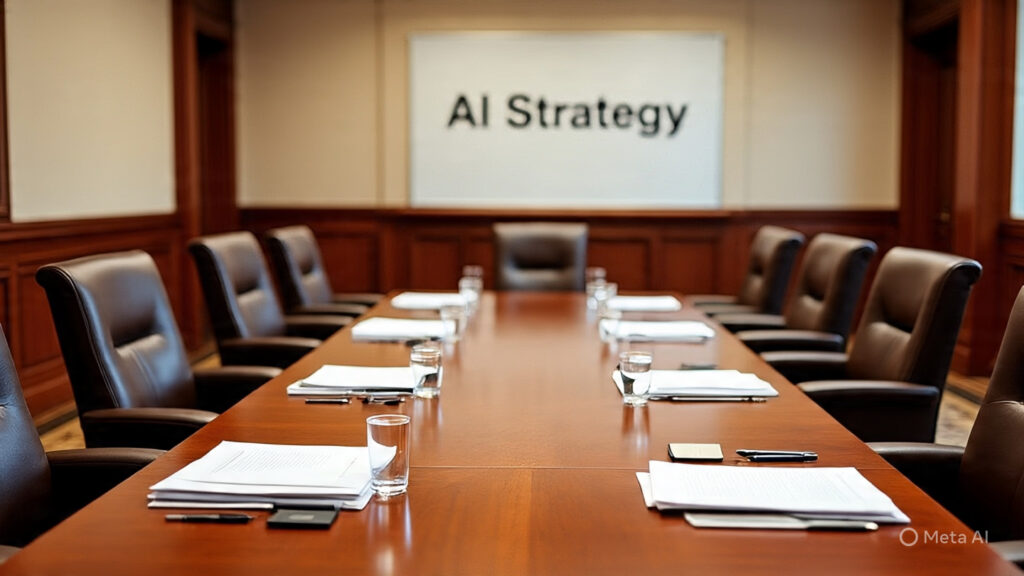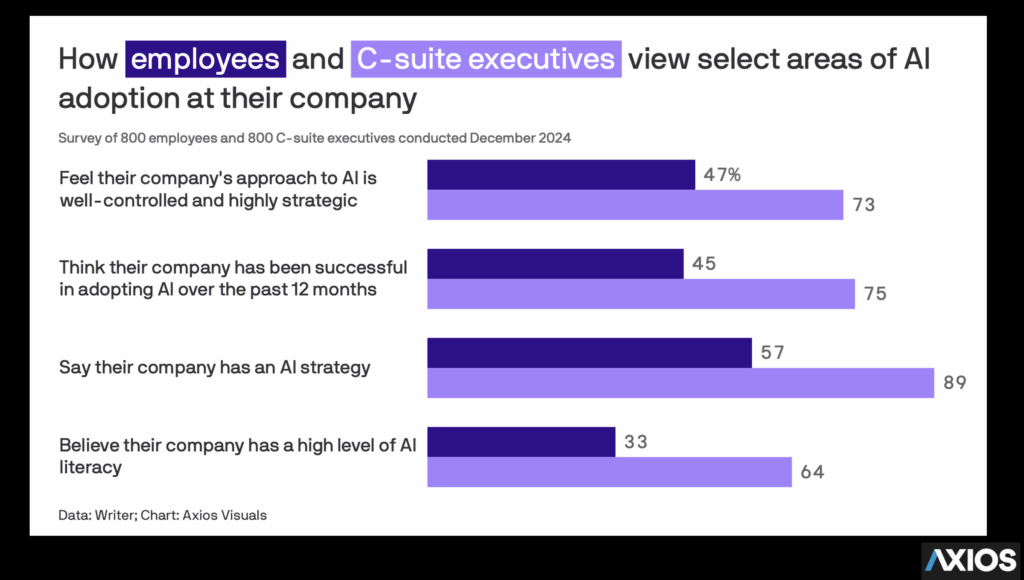
Let me ask you a question…
What’s moving faster, AI innovation or the rate at which organizations fall behind?
While AI continues to advance at breakneck speed, many legacy companies are struggling to keep pace. The real challenge isn’t the technology itself, but the growing gap in alignment and execution. Most CEOs and board members believe they’re confidently leading their organizations into the AI era. Yet new data reveals a stark disconnect between the C-suite and frontline employees when it comes to what’s actually happening on the ground.
According to an Axios survey that interviewed CEOs and their employees, separately, AI vision, strategy, and capacity may be a dangerous illusion.
Axios learned that CEOs may feel they are steering their companies into an AI-powered future. But if the people responsible for delivering on that vision don’t feel informed, empowered, or included, then the transformation will fail to take root. Sound familiar?

Let’s talk about it!
C-Suites are mistaking AI vision with tactical strategy. And they’re mistaking AI strategy for strategy activation. Employees don’t feel the impact, which means vision isn’t articulated and strategy isn’t embedded.
The Illusion of Vision and Strategy
Nearly 90 of C-Suites say their company has an AI strategy. Yet only 57% of employees believe that to be true.
This suggests that while the strategy might exist in executive slide decks or boardroom conversations, it hasn’t been translated into the day-to-day reality for most employees. For them, the strategy is either invisible or irrelevant. Again, sound familiar?
The Illusion of Success
Executives also believe they’ve made meaningful progress. Seventy-five percent say the company has been successful in adopting AI over the past 12 months. But just 45% of employees agree. If employees aren’t feeling the impact of success, that means the change isn’t penetrating deeply enough. If those delivering the work don’t feel the benefits, innovation won’t scale.
The Illusion of Control
Another significant divide emerges when asked whether the company’s approach to AI is “well-controlled and highly strategic.” While 73% of C-suite leaders say yes, only 47% of employees agree. That’s a 26-point gap in perception and reality!
A strategy is only as effective as it is understood and executed across the organization. If people perceive confusion or chaos where leadership sees control, well, you can imagine what happens next.
From Illusion to Introspection
If the first set of data reveals a disconnect between leadership and the workforce, the second reveals something even more revealing. Here, we shift to a profound introspection among CEOs themselves. They reveal more than disconnects in communication. They’re disconnects of modern leadership.
The illusion of progress is being shattered by the very leaders tasked with shaping the future. CEOs are quietly confessing that AI is transforming how businesses operate. And it’s redefining who leads, how decisions are made, and what it takes to stay relevant.
Let’s compare these findings to the Dataiku/Harris, “Global AI Confessions Report: CEO Edition.” This survey of 500 CEOs worldwide unveils startling admissions and revelations of Al’s impact on corporate leadership and competitive survival.
94% of CEOs admit an Al agent could provide equal or better counsel on business decisions than a human board member.
What it means (WIM):
The boardroom is no longer immune to disruption. AI literacy is now a fiduciary responsibility. Boards must evolve from oversight to insight, becoming fluent in AI, risk, and opportunity at the same pace as the technology itself.
What to do (WTD):
Establish an AI Board Advisor Program to embed AI-powered agents and advisors alongside traditional governance models.
Test AI-simulated board scenarios to understand what it sees that your board doesn’t.
89 of CEOs feel AI can develop an equal or better strategic plan than a member of their own exec team.
WIM:
Strategic planning is no longer a purely human exercise. The executive bench must now compete and collaborate with algorithmic intelligence and do so quickly and visibly. The future leadership team will be hybrid: human + digital counterparts.
WTD:
Augment strategic planning with AI agents that simulate market changes, competitor responses, and future scenarios (agents as digital twins FTW!)
Redesign the org chart with AI-native roles. Train your teams to collaborate with AI not just as tools, but as cognitive partners.
74% of CEOs admit they’ll lose their job within 2 years if they don’t deliver Al business gains.
WIM:
The AI clock is ticking, and the innovation imperative is rising. AI native companies are moving the game from an era of AI experimentation to execution. AI-forward boards and shareholders will learn to see AI beyond a tool or technology investment, and instead as a performance expectation and competitive driver.
WTD:
CEOs must shift from exploring peer-driven AI use cases to engineering AI-native business models. Leaders must stop waiting and start leading.
Create an AI Transformation Office to orchestrate enterprise-wide AI initiatives, beyond the AI ‘status quo’ pilots.
Tie AI metrics to business outcomes including, revenue growth, margin expansion, NPS, time to market. Develop a real AI vision!
Publish a 12-month AI innovation roadmap to the board, employees, and investors. Then, deliver and report against it.
68% of CEOs claim they are involved in more than half of their companies’ Al-related decisions.
WIM:
CEOs understand, or are starting to, grasp the stakes and are stepping in and stepping up. But involvement doesn’t equal empowerment. AI readiness, AI fluency, and AI empowerment must be democratized across the enterprise, as tied to the vision.
WTD:
Build AI leadership coalitions or cross-functional stakeholder groups across functions, influencing but not limited to IT, to scale decision-making.
Bring in the outsiders to develop and execute an AI upskilling initiative across all management tiers.And perhaps the least intuitive of the bunch, distribute decision-making authority to AI-augmented teams trained to act with speed and insight.
From Reckoning to Renaissance
This is a reckoning and the beginning of something bigger. It’s AI transformation tied to leadership transformation.
The AI era demands a new leadership mindset. A new vision for what’s possible. A new language. A new social contract between leaders and their organizations.
That starts by closing the gap between perception and reality. It means rethinking leadership. It means moving beyond platitudes. You can’t scale what your teams don’t understand. And you can’t scale what you do not understand.This moment demands a bold new vision and a clear strategy. It demands action and empowerment across the organization. It also demands measurable alignment between boardroom intent, C-Level promises, and frontline execution.
Without vision and alignment, AI remains theater. Without shared understanding, transformation stalls. And without communication and enablement, trust fails to materialize. The companies that succeed unite AI and business leadership, innovation, and culture.
The renaissance starts with a mindshift.





Leave a Reply